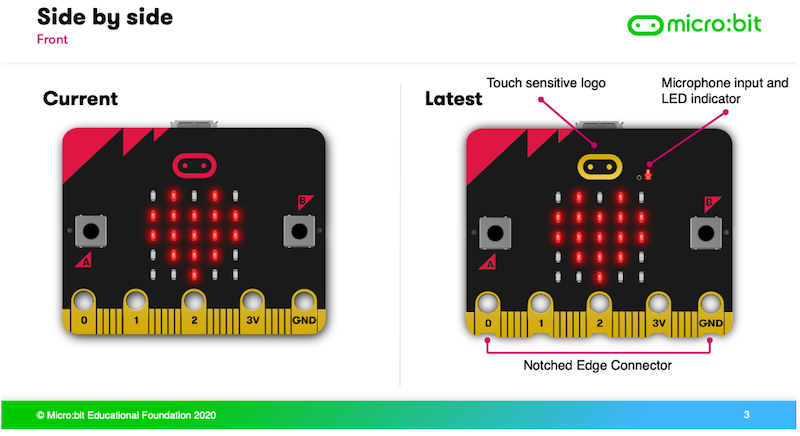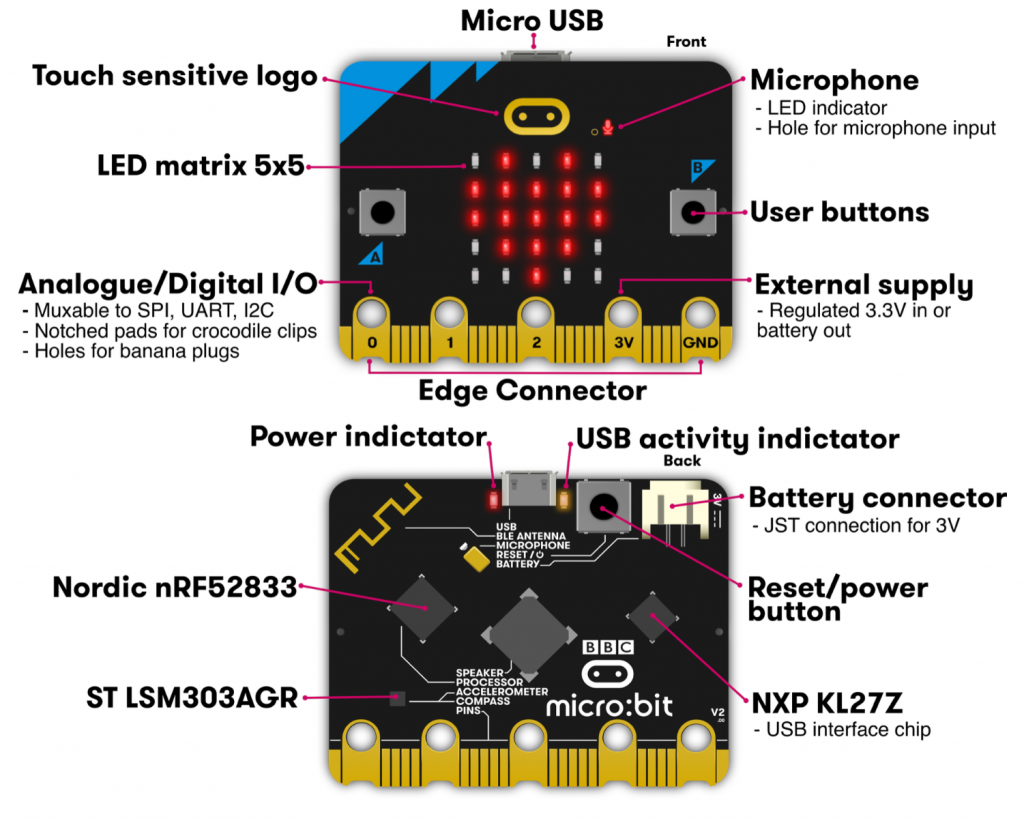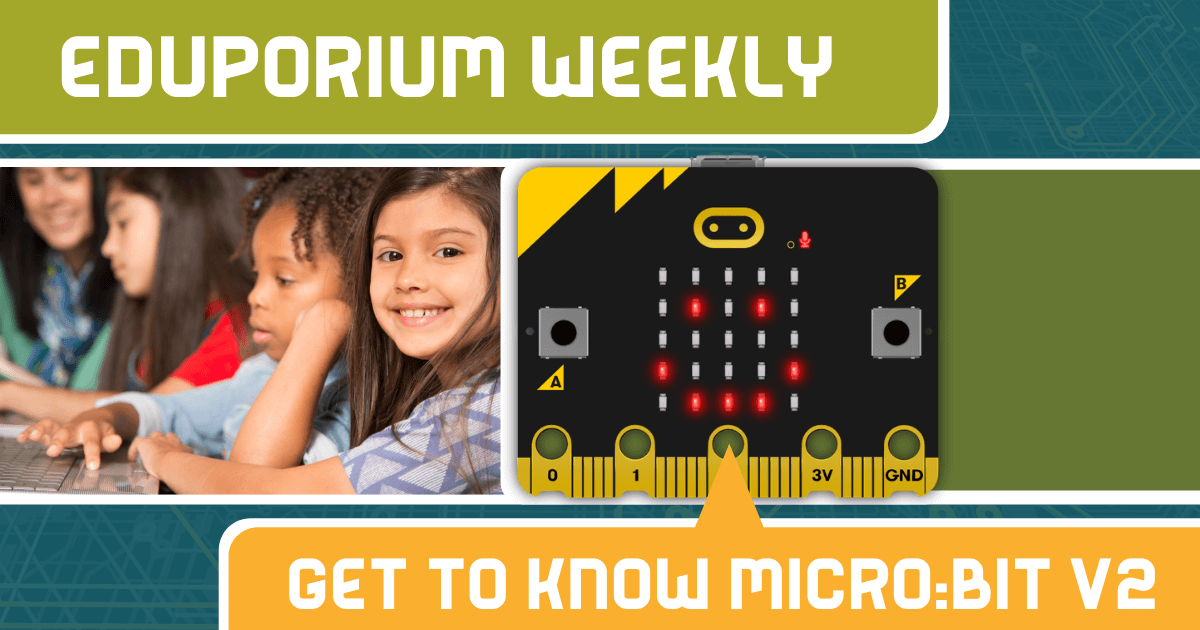If you haven’t heard, the all-new version of the popular micro:bit computing tool is set to impact education at the start of 2021. The new micro:bit V2 will begin shipping in January and is currently available for pre-order on our store. We anticipate it being very popular and recommend educators get pre-orders in sooner rather than later. In terms of looks, the micro:bit V2 is similar to the original micro:bit and costs roughly the same as well. It has many more capabilities, however, and adds more excitement to coding with a built-in speaker, microphone, and LED matrix.
New Features: Speaker and Microphone
Two of the most prominent and exciting differences with the micro:bit V2 are its built-in speaker and built-in microphone. It essentially allows your micro:bit to project and sense or react to sounds, respectively. These also allow students to add new elements to their CS projects and create programs with added interactivity. The primary way in which students can code with their micro:bit V2 is using the MakeCode program on a computer or other device. Now, they can create programs with MakeCode blocks and commands that use one or both of these new parts. We should also note that these two components make sound-sensing and sound-making possible without the need for students to attach an additional device to their micro:bit.
The programming side allows the micro:bit V2 to produce sounds once it detects an environmental trigger. Beyond that, students aren't limited to creating programs and animations with only the presence of sound. Using the other programming features of the micro:bit found within MakeCode, they can create programs with many different elements, including the use of sounds to enhance what they’re trying to communicate or demonstrate through the program. If they’re programming a happy face on the LED matrix, for example, they can also include upbeat sounds to go along with what flashes on the board. This is one potential way to tie in social-emotional learning with STEM as students create programs to express their emotions.
Students can also control the pitch of sounds by tilting the micro:bit in different ways thanks to the built-in accelerometer. They can also program their micro:bit to respond to sound inputs, allowing for experiments involving lighting up the LEDs on the matrix when the micro:bit senses a sound, like their voice or clapping their hands. These are just some examples and it’s definitely possible for students to incorporate sound in different ways using the sensors. Whether students want to use sounds from the classroom or their home learning space to drive programs or want to create their own sounds for their programs, the speaker and microphone help make a lot more projects possible.

Technical Specs and Physical Appearance
As noted, the micro:bit V2 looks similar to the original and is not more expensive despite its improvements. We’ve mentioned its audio capabilities, including the speaker and microphone, which were previously only possible when adding an expansion board. We should also mention the two new LED lights—one that lets you know when the microphone is on and another to serve as a power indicator. The power indicator is on the backside of the micro:bit V2 along the edge. It can also go to sleep when not in use, so students don't need to disconnect the battery each time. Another cool improvement is the adoption of a notched edge on the bottom of the board where you can connect alligator clips. Previously, this edge was straight but these built-in notches now allow for better connections when attaching alligator clips or conductive thread.
One of the other cool changes to the new micro:bit is the micro:bit logo above the LED matrix. You should notice it’s a different color than that on the previous version but that’s not the only difference. The new logo also acts as a capacitive touch sensor, which provides an additional way of interacting with programs. The logo is touch-sensitive—a feature the original micro:bit board did not have—and can act as an input. Thus, students can use it in the same way as the board’s two buttons in program creation with MakeCode. What this essentially means is that students can write commands that execute code upon the physical touch of the board’s logo presumably by the tap of a finger.
In terms of power, the micro:bit V2 processor is upgraded (it’s now the nRF52833), which enables it to offer twice as much flash memory and eight times as much RAM. It also features an upgraded voltage regulator, which provides an additional 110 mA of power for using with accessories. This paved the way for one extra GPIO pin (now four instead of three) and the board has Bluetooth capabilities. As for software, much of the core functionality of the board has remained the same—that's important because this means students can rebuild any current micro:bit programs they have for use on the new board without losing them. They could do this by simply dropping their hex file into the editor they used to create it originally—and those are just some of the technical specifications of the micro:bit V2.
Lesson Plans and Project Ideas
As you might have guessed, the micro:bit V2 unlocks so many new projects students can complete. There are those they can do individually or collaboratively and options for remote or in-person learning. With new possibilities, it can get a little hectic for teachers learning to use the board themselves. For that reason, the simplicity of micro:bit Classroom and the resources inside help make this process much simpler. If you’ve never used it, micro:bit Classroom is an online platform developed by the micro:bit Educational Foundation team. Educators can use it to find and share projects, manage activities, track student progress, and more. They can also share code with kids in MakeCode or Python, making it easy for them to program anywhere.
Within micro:bit Classroom, teachers can access instructions for lessons, find the Python and MakeCode editors, see student code, and more. Once they set up their classroom and name it, a code will appear to share with students. Students can also use the unique code to access micro:bit Classroom from their own device wherever they're learning. Teachers can then create a new activity, choose a coding language, and launch their classroom. Outside of micro:bit Classroom, you can easily find instructions for getting started with the micro:bit as well as their library of coding projects for beginner, intermediate, and even advanced programmers. The Projects, Lessons, and Let’s code tabs at the top of the micro:bit website each contain valuable information, especially the Projects tab, which we’ll explore in detail right about now.
That project catalog helps make it easier to find exciting activities to complete with the micro:bit V2. There are over 75 projects across various skill levels with new ones added regularly. Educators can easily choose from beginner, intermediate, and advanced projects and browse the selection to find something interesting. Or, if they have something in mind, the filters help them quickly find something relevant. Teachers can also filter the project ideas by programming language (MakeCode, Python, or Scratch). Students can complete almost all the projects with both MakeCode and Python and a small amount are for Scratch. They can also filter projects by subject and topic (computational thinking, digital arts, design and technology, and more) or by device feature (accelerometer, buttons, compass, and more). So, if you’re considering pre-ordering the micro:bit V2, we’d recommend browsing the project library and micro:bit Classroom to get excited.
More On the Tech in the micro:bit V2
There's so much interesting and useful technology in the micro:bit V2. From its touch sensitive logo to the accelerometer and, of course, the built-in speaker and microphone, this small board will make an incredibly useful STEAM education tool. Now, we’ll get deeper into the actual technology and, if you understand tech lingo, this section is for you. We’ll start easy with the V2’s size. It measures just 5 cm x 4 cm and hardly has any weight, making it easier to use and transport around schools or makerspaces or for sending home with kids. It also has 512 kB of flash memory and 128 kB of RAM. Students could pair it with computers using a USB cable (included in some kits) or pair it with Bluetooth-compatible devices.
As we’ve mentioned, the yellowish logo on the front is touch sensitive—the only spot that’s responsive to touch. Then, there are the edge connectors, which involve one of the key aesthetic updates to the V2. The board's edge (where the connectors are) is notched to make it easier to connect crocodile clips or banana plugs. Depending on what kids connect, the micro:bit can also possibly read things, like motors or robots. It can also still utilize its Bluetooth 5.0 capabilities to establish connections with other devices too. Beyond that, the micro:bit V2 has a motion sensor (a 3-axis digital accelerometer) that can detect movements, like shaking, tilting, or free fall, which kids can use in their MakeCode programs or motion activated games.
There are 25 individually programmable LEDs on the matrix, which kids can program to show text, images, or numbers. There are also two sensors they can use: the light sensor and a temperature sensor. The light sensor allows students to detect light to activate certain elements of programs and functions by reversing the LEDs on the matrix to become inputs. That temperature sensor then allows the micro:bit to detect the temperature in its environment, which students could also incorporate in programs. Finally, the micro:bit’s accelerometer measures the acceleration of the micro:bit and senses when it's moving. The micro:bit can communicate this information wirelessly via radio or Bluetooth. The radio communication allows sending messages to other micro:bit’s and the Bluetooth communication allows it to control phones or tablets.

The Options for V2 Kits
Since the micro:bit V2 board looks similar to the originals, it makes sense that options for purchasing are similar, too. Both in the pre-order period and once the V2’s start shipping, there are four options available for purchases: The V2 Single, the V2 Go, the V2 Club Pack, and the V2 Bulk Pack. So, let’s start with that V2 Single Pack. If you’re looking for just one new micro:bit without any additional accessories, this might be the best option for you. The only components in the box are the micro:bit board and a user guide (this option does not include any USB cables, battery holders, or AAA batteries) but, of course, it is the same micro:bit V2 board with all the new features in each of all the other kits.
The second option is the micro:bit V2 Go Kit, which is just one dollar more than the Single pack. The major differences between these two kits is the inclusion of those three accessories that aren't in the Single pack. The micro:bit V2 Go comes with a USB cable, one battery holder, and AAA batteries. These cables connect the micro:bit boards to laptops or computers, allowing students to transfer programs to the micro:bit itself. Also, the battery holder is usually used in those more complex projects that require additional power. Rest assured, however, the battery holder is not completely necessary for every project students create. If you think this is something you might be able to live without, you can find a list of materials you'll need for the various projects in the project library on the micro:bit site that we told you about earlier.
Next, we have the micro:bit Club Pack, which is just 10 micro:bit Go packs with 10 times the materials. The Club Pack supports smaller classes or perhaps an afterschool coding club and it comes with 10 micro:bit V2’s, 10 USB cables, 10 battery holders, 20 AAA batteries, and 10 user guides. The 10 units of each enable easy distribution and, if working with additional students, educators can buy more. Finally, the last option is the V2 Bulk Kit, which contains 300 micro:bit boards. In addition to 300 micro:bit's, it comes with 300 user guides as well. Like the Single pack, however, it doesn't include the USB cables, battery holders, or any of the batteries. Perfect for distributing throughout a school or district, the Bulk Kit is perfect for large-scale computer science projects or rollouts.
For the latest EdTech, STEM, and 21st century education news, follow us on Twitter and Instagram. Like us on Facebook, too, or sign up for our newsletter for our latest product announcements and offerings. If you have an idea for an Eduporium Weekly theme, send us a message on social media or comment below.



